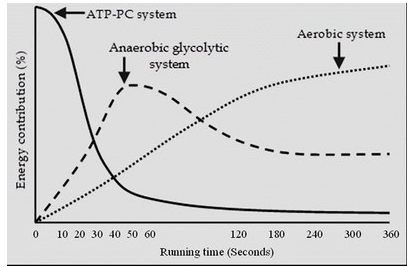The breakdown of one chemical Andenosine Triphosphate (ATP) powers every single movement in the human body. An ATP molecule consists of one adenosine and three (tri) phosphate groups. The breakdown of ATP to release the stored chemical energy within its high energy phosphate bonds is known as ATP hydrolysis (hydrolysis =breakdown with water).
The body stores a very small amount of ATP within the muscle cells, but this amount is burned up within just a few seconds. The body must then synthesize new ATP in order to constantly fuel movement. The process of synthesizing ATP in the presence of oxygen is called aerobic metabolism and if it occurs without oxygen it is called anaerobic metabolism.
There are three separate energy systems through which ATP can be synthesized,
- ATP-PC (phosphocreatine) (also known as the phosphagen system)
- Anaerobic Glycolytic system(also known as the lactate system)
- Aerobic system (also known as the slow glycolysis or oxidative phosphorylation)
Most Exercise involves ATP being synthesized through a mix of all three systems. The intensity and duration of exercise determine which system is most dominant at any time. The graph below shows the percentage of energy provided by each system during the first six minutes of cycling.

When you start to exercise your energy will come from the anaerobic energy systems, the initial 10-15 seconds are almost exclusively through the ATP-PC system. As exercise continues the anaerobic systems become depeleted due to limited stores of ATP and the aerobic system becomes increasingly dominant as it breaks down more complex fuels for energy such as fats, proteins and glycogen.
The higher the intensity of the exercise the quicker the anaerobic systems will be depleted. To continue exercising once the anaerobic systems have become significantly depleted the intensity of the exercise needs to drop to a level that allows the aerobic system to provide enough energy.
By training short intense efforts above your FTP for 30-60 seconds you can exhaust the anaerobic systems and then force the body to reload stored ATP for the next intense effort, during short recovery bouts. The more efficient an athlete is at replenishing ATP stores the more high intensity efforts can be completed.
